How Paid Search and SEO work together
Paid and SEO are often seen as opposite sides of the same coin; Paid works with speed, while SEO plays a longer game. Paid is extremely audience specific, while SEO takes a wider funnel approach. Paid only offers ads for as long as you pay… while SEO can provide great ROI for as long as content is live and accessible to users. Ultimately though, both are great for the same reason:
They help your company connect with users in one way or another.
So instead of working against (or at least adjacent to) each other, these two have the power to balance your marketing strategy so you never miss another user in the funnel again. In order to help you see that paid and organic search efforts both deserve to be part of your digital marketing plan, this article will shed light on the ways you can leverage both together with the following:
Quick Link Menu
- The difference between Paid Search and SEO
- Pros and Cons of Paid and SEO (Infographic)
- How do Paid Search and SEO work together?
The difference between Paid Search and SEO
Put simply, Paid Search refers to Pay-Per-Click (PPC) advertising, while SEO (Search Engine Optimisation) is the process of optimizing a website to improve its organic visibility on search engines. With PPC, companies place ads on search engine results pages (SERPs) and pay a fee each time a user clicks on the ad. Google Ads is one of the most popular platforms for this, allowing businesses to bid on keywords relevant to their products or services. SEO involves on-page optimization, content creation (AI generated or otherwise), link building, and technical enhancements to make the site easier for Google to view and understand.
What are the pros and cons of both?
We could talk for hours on the advantages and disadvantages of both, (if you’d like us to, please drop us a line), but the pros and cons of each will vary depending on your business needs and desires.
Generally speaking, paid is more sales and leads focused and has advantages towards these marketing efforts. On the other hand, SEO can be slightly wider in scope as you can tailor any page to be more conversion focused, like for ecommerce, or more editorial for informational and research stages of the marketing funnel. To help clear up which to choose depending on certain vectors, we’ve created a dedicated infographic below.
The difference between SEO and Paid

Speed
SEO – Long-term
Results take a longer time to show in SEO as search engines take time to read, understand and recommend your site
Paid – Quick Results
You can set up and run ad campaigns in a matter of minutes depending on assets needed
Audience
SEO – Wider Funnel
You can create pages to handle stages of the marketing funnel, but the audience reaching your site is not selected
Paid – Detailed Targeting
You can narrow in on your target audience with metrics like demographic, location and interests
Channels/Mediums
SEO – Search Engines
SEO mainly focuses on pages found by search engines such as Google
Paid – Mixed
Ads can be run on several channels, in different mediums like video, by influencers or by email
Competition
SEO – Need to Prove Expertise
SEO requires revision and emphasis on high quality content for search engines to recommend you
Paid – Reach 1st position easily
If you’re willing to spend, you can cut through the noise in highly competitive industries quickly
Longevity
SEO – Sustainable
Well optimized sites can provide consistent results
Paid – Transient
PPC results are more immediate, meaning it can be hard to measure their effect once ads are switched off
ROI
SEO – More Economical
In the long term, as you can attract free traffic to your site once pages are well optimized
Paid – Low to Moderate
Because clicks stop when ads stop
How Paid Search and SEO complement each other

As mentioned previously, both PPC and SEO will drive traffic to your site. The ways in which they do this, and the data you collect when they do, can help inform both SEO and PPC strategy when it comes to keywords you want to target, the content you need to produce for users to ease pain points and benchmarking marketing success.
Keyword strategy
Both PPC and SEO rely on targeting keywords that users type into the search engine bar. Through PPC, you will have full control over the keywords your website will appear in results for, allowing you to quickly test the performance of various keywords and identify the most high-converting terms. This in turn allows you to change meta titles, keyword strategy and keyword focus for parts of your website to have a higher potential to rank with keywords organically.
For example, you might find that your ideal audience actually searches and converts more on “cloud software” rather than “cloud computing” when they are actually looking for the same thing. Or, perhaps a long tail keyword like “how to start investing” is a more natural user search journey to advertise your stock investment services than keywords like “stock investment app” or “stock investment platform.” With that information, you can adjust your commercial landing page to include more educational points to help ease user barriers to conversion. There may even be cases where SEO keyword research unearths new keyword opportunities to add to adverts or vice versa. Eventually all this compiled keyword research will help you understand the most high value keywords that Google believes you are most relevant for.
Content synergy
PPC gives you granular visibility over your target audience, and the ability to quickly test different versions of ad creatives. This data shows how your ideal consumers react to different content and ad creatives to help redesign and restructure your pages for SEO. You can test the best CTR and adjust meta-data, CTAs on page, imagery, speed to answer and general UX or user journeys accordingly.
Let’s say you work in the fashion industry, creating tailored ecommerce ads on Google. You notice how consumers are more likely to convert when ad copy includes a reference to trends/ or following the most trendy options, or even the imagery of a trend line in the ad creative. You may want to change some of your messaging on site to make users feel like they are missing out on a trend or add the mention of trend to the meta title to create a sense of urgency to click through.
All this content information doesn’t need to be one directional either – you can easily review your most successful editorial or commercial SEO pages by clicks to help create better converting ads, too. This data can also inform you to develop more tailored digital PR and outreach campaigns to better reach your target audience.
Benchmarking progress & seasonality trends
In digital marketing, we constantly measure SEO performance to help understand KPI peaks and troughs and re-prioritize optimisation efforts. Sometimes a key part of fluctuations in page metrics can simply be attributed to seasonality around search. PPC efforts and keyword planner data is a great way to understand how topic search volumes change across the year.
Predicting seasonal searches can help prioritize our efforts across the SEO content arms of a site and campaign launch timelines. This kind of data is particularly important in digital marketing for the travel industry, where consumer purchasing behavior around flights and holidays has fluctuated greatly in the wake of COVID and ‘bleisure’.
Final thoughts
Clearly, the integration of Paid Search and SEO is not just a best practice; it’s a necessity for your business in today’s competitive digital landscape. Combining both can help you maximize visibility, and drive sustainable growth.
As a full-service marketing agency, we always encourage our clients to embrace this synergy to stay ahead of the curve and continuously refine their digital marketing efforts. Send us a message today to learn about how we can work together to improve your SEO and Paid Search efforts.


